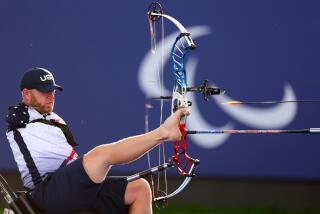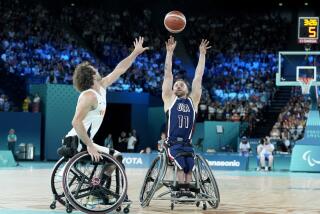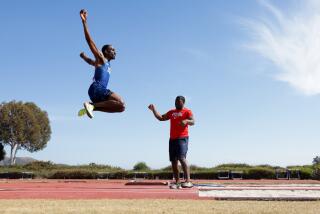PERSONAL HEALTH : Athletes With Disabilities Get a Workout
Nicky Weiland made a beeline for the wooden dance floor at the Main Street Fitness, Dance & Aerobics Center in Santa Monica.
Dressed in a white tank top and jeans, the 14-year-old warmed up slowly and then grinned smugly as he saw his image in the mirrored walls.
Soon, he was crooning into his hand-turned-microphone as he continued to exercise, much to the delight of the audience of parents and others observing this “special aerobics” class.
The Saturday afternoon class is reserved for students like Nicky, who has Down’s syndrome, and others with physical or mental disabilities. It’s an hour of nonstop exercise--stretches and dance movements--carried out to the eclectic background beats of hip-hop, country and heavy metal tunes. At the end of class, Nicky fell into his mother’s arms and gave her a bearhug.
“Ooooh, somebody needs a shower,” Gail Weiland said with a laugh.
“These students are so into it,” says David Roberti, the studio’s creative director, who began teaching the class nine months ago. “They write me letters telling me how much they love taking it.”
Main Street’s special aerobics class, which is free, is just one of the burgeoning fitness opportunities for physically or mentally disabled exercisers.
Organizations such as National Handicapped Sports are training instructors and sponsoring athletic events across the country. Improvements in wheelchairs and other equipment are making activity easier for amputees and others with special needs. And acute injury rates among disabled exercisers, a recent study suggests, are no higher than among other athletes.
Four years ago, National Handicapped Sports had 50 chapters, says Steve Fulkrod, a spokesman for the Maryland-based group. Now there are 82, including two in Southern California, that offer sports competitions, recreational opportunities, skiing instruction and more.
“We also train and certify instructors in adaptive skiing and adaptive aerobics,” Fulkrod says. Another organization, the National Wheelchair Athletic Assn., sponsors events in archery, track and field, shooting, swimming, table tennis and weightlifting, a spokeswoman says.
There are also sports camps for athletes with special needs. Sunrise Medical’s Quickie Design Inc., a Fresno-based wheelchair manufacturer, sponsors basketball and tennis camps featuring outstanding wheelchair athletes as teachers.
Equipment improvements are also making exercise easier. InvaCare, a wheelchair manufacturer, has a new, lighter-weight Action Line.
“A standard wheelchair weighs 33 to 45 pounds,” says Sharon Raymond, a company spokeswoman. “The Action Line chairs are about 21 to 27 pounds.” All of the Quickie Design chairs weigh less than 30 pounds, a spokeswoman says.
The field of biomechanics is also helping. “There are now many ways to compensate for limb loss,” says Dr. Joseph M. Czerniecki, assistant professor of rehabilitation medicine at the University of Washington.
Prosthetic devices, including feet, have improved greatly, he says. Adaptive use of equipment can also help people exercise and compete. Amputee skiers, for instance, often use a regular ski on the intact leg and carry two crutches with mini-skis attached.
For exercisers who can’t make it to class or to the slopes, National Handicapped Sports offers five videotapes. The exercise regimens are geared to people with paraplegia, quadriplegia, lost limbs, cerebral palsy and other conditions.
Disabled athletes are not more prone to acute injury than other athletes, suggests a recent study published in the American Journal of Sports Medicine.
Michael Ferrara, assistant professor of physical education at Ball State University, surveyed 68 disabled skiers who participated competitively in winter games and concluded that they incurred about the same proportion of acute injuries as able-bodied skiers.
The skiers did tend to get more overuse injuries, though, especially in the shoulder and legs, Ferrara says. “We don’t know, though, whether those overuse injuries are sports-related or disability-related,” he says. “We are studying that now.”
Disabled exercisers often have a higher motivation, greater acceptance of the disability and a higher functioning level than those who are sedentary, Ferrara says. “Obviously, get a physician’s clearance first,” he says. “Then each individual should find his or her exercise tolerance level. But any type of recreational activity is positive.”
* Main Street Fitness Dance & Exercise Center, Santa Monica, offers a weekly one-hour special aerobics class on Saturday. Call (310) 396-4747.
* National Handicapped Sports sponsors activities and competitions nationwide and offers videotape workouts. Its Ski Spectacular for Disabled Skiers, Dec. 6 to 13 in Breckenridge, Colo., is expected to attract more than 500 skiers. For information or referrals to local chapters, call (800) 966-4647 from 9 a.m. to 5 p.m. EST, Monday through Fridays, or write NHS at 451 Hungerford Drive, Suite 100, Rockville, Md. 20850.
* National Wheelchair Athletic Assn. publishes a quarterly newsletter and organizes competitions in 10 regions nationwide. Membership is $25 a year. Write 3595 E. Fountain, Suite L-1, Colorado Springs, Colo. 80910.


